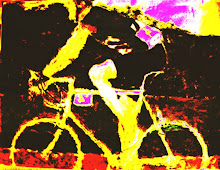I was now to move onto the creation of Manny's torso. With his torso, I was aiming to create a fairly accurate rendition with as smaller number of Polygons as I could, so as to appear close to a real-life example without being overly complex - which would only lead to problems when attempting to apply with UVW Maps and Skinning later on
Starting off with a Box 6x6x6 H/W/D segments, I proceeded to select the four corner Polygons that would part of the beginning of Manny's front shoulder/clavicle area. I knew I needed to make use of all four viewports when adjusting these, so I made sure the viewport layout was as shown here
These Polys were subsequently move downwards to imitate the shape of a male's lower shoulder, going towards his pectorial area, while leaving room to repeat this for the rearward shoulder area and nape of the neck
A similar method was applied to the four Polygons nearest his waist/hips - these were brought inwards with the use of the Scale tool
I then needed to choose an area of four Polys situated in the centre of the upper torso surface which could be extruded for Manny's neck. Notice how, in this screen, there is the gentle slope of the shoulders either side of the ridge that is going right between the selection I have made here - this should be more pronounced when the MeshSmooth is applied
I used the Bevel tool to allow the Polygons to open outwards slightly when the desired height had been reached
The same neck area (facing forwards) with a simple MeshSmooth modifier applied. Notice how the neck looks too streamlined and narrow across the depth of the torso? This will be adjusted to compensate for Manny's Head (which, incidentally, will be bridged onto his torso next week)
In order to obtain a similar level of detail to the rear of Manny's torso, I took it upon myself to use a technique whereby selecting alternate Polys and Edges can allow me to manipulate the muscle structure and defined appearance, but avoiding a complex, multi-polygonal mesh that would be excessively overdeveloped for the purposes of this module
Here, I am selecting opposing edges and pushing them along both the X and Z axis, inwards and upwards to acheive the common definition found on the majority of male mannequins front torso - pectorials and laterals (I frequently referred back to my reference images taken of real-life mannequins to maintain artisitc accuracy!)
This was the start of (attempting) to re-create a moderately-defined stomach area, modelling a series of small adjustments with the use of the Cut tool to map out alternate Polys if I wasn't having any success with the ones pre-determined by the Primative Box Object
The use of the Rotate tool was important; I could gather various edges and, by rotating them thorugh the X axis, the appearance of the pecs and other features become more pronounced, without me needing to revert into creating more and more vertices and, potentially, causing alot of hassle for future changes that could always be made unexpectedly
My first series of adjustments rendered: it is clear where further manipulation needs to be made (more detailing across the stomach, pecs and definition for the clavicle and lats)
I decided to try the chamfer tool; it creates two edges out of one and can be used to extensively deepen a models formal structure, and surely a vote for improvement of Manny's muscle definiition!
Here, I am incorporating the Chamfer tool to be used across the lateral definition, adjacent to the central area, which I have tried to improve by raising and lowering the protrusion of each of the edges
A render of the result of this idea: sadly, not as immeditately effective as I was hoping for, but its clear how effective this tool is for lateral edges, perhaps rather than longitudinal ones
Approaching this from a renewed perspective, I then commeced with the removal of the upper Poly's, so that I can attach Manny's head at a later date. Also, notice the inclusion of a Chamfered edge at the foreward nape of the neck
These two screens demonstrate the varying degrees of trail-and-error needed to manipulate and modify various Polygons, Vertices and Edges in order to achieve the definition I had staring back at me from my reference images - the Chamfer tool was used to enhance certain edges and Rotate tool was again used to add futher detail to the laterals
The finished product - yes, I may have to add more at a later date, but not only do I not have the time to keep returning back the the same items again and again, perhaps it's a godsend that the module doesn't specify that character models need to be extensively detailed and finely modelled in every minute area...all I can say is, I'm happy with this right now!









































